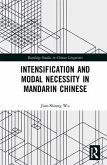Robert Neal
Intelligibility, Tones and Young Beginner Learners of Mandarin Chinese
Robert Neal
Intelligibility, Tones and Young Beginner Learners of Mandarin Chinese
- Gebundenes Buch
- Merkliste
- Auf die Merkliste
- Bewerten Bewerten
- Teilen
- Produkt teilen
- Produkterinnerung
- Produkterinnerung
Set within the context of teaching and learning Chinese at an inner-city secondary school in the North of England and adopting a case study research design, this book aims to develop research-informed insights into the nature of the pronunciation challenges facing beginner learners of Chinese.
Andere Kunden interessierten sich auch für
![Colloquial Yoruba Colloquial Yoruba]() Antonia Yetunde Folarin SchleicherColloquial Yoruba204,99 €
Antonia Yetunde Folarin SchleicherColloquial Yoruba204,99 €![Interaction in Mandarin Chinese and English as a Multilingua Franca Interaction in Mandarin Chinese and English as a Multilingua Franca]() Weihua ZhuInteraction in Mandarin Chinese and English as a Multilingua Franca204,99 €
Weihua ZhuInteraction in Mandarin Chinese and English as a Multilingua Franca204,99 €![Nantong Chinese Nantong Chinese]() Benjamin AoNantong Chinese204,99 €
Benjamin AoNantong Chinese204,99 €![Assessing Oral Strategic Competence of Young Language Learners Assessing Oral Strategic Competence of Young Language Learners]() Jun WangAssessing Oral Strategic Competence of Young Language Learners206,99 €
Jun WangAssessing Oral Strategic Competence of Young Language Learners206,99 €![Intensification and Modal Necessity in Mandarin Chinese Intensification and Modal Necessity in Mandarin Chinese]() Jiun-Shiung WuIntensification and Modal Necessity in Mandarin Chinese227,99 €
Jiun-Shiung WuIntensification and Modal Necessity in Mandarin Chinese227,99 €![Practical Mandarin Conversation Practical Mandarin Conversation]() Frank LeePractical Mandarin Conversation18,99 €
Frank LeePractical Mandarin Conversation18,99 €![Learn Russian with Dracula Versus Manah Learn Russian with Dracula Versus Manah]() Vadym ZubakhinLearn Russian with Dracula Versus Manah35,00 €
Vadym ZubakhinLearn Russian with Dracula Versus Manah35,00 €-
-
-
Set within the context of teaching and learning Chinese at an inner-city secondary school in the North of England and adopting a case study research design, this book aims to develop research-informed insights into the nature of the pronunciation challenges facing beginner learners of Chinese.
Hinweis: Dieser Artikel kann nur an eine deutsche Lieferadresse ausgeliefert werden.
Hinweis: Dieser Artikel kann nur an eine deutsche Lieferadresse ausgeliefert werden.
Produktdetails
- Produktdetails
- Verlag: Taylor & Francis Ltd
- Seitenzahl: 168
- Erscheinungstermin: 13. März 2025
- Englisch
- Abmessung: 234mm x 156mm
- ISBN-13: 9781032169835
- ISBN-10: 1032169834
- Artikelnr.: 71808583
- Herstellerkennzeichnung
- Libri GmbH
- Europaallee 1
- 36244 Bad Hersfeld
- gpsr@libri.de
- Verlag: Taylor & Francis Ltd
- Seitenzahl: 168
- Erscheinungstermin: 13. März 2025
- Englisch
- Abmessung: 234mm x 156mm
- ISBN-13: 9781032169835
- ISBN-10: 1032169834
- Artikelnr.: 71808583
- Herstellerkennzeichnung
- Libri GmbH
- Europaallee 1
- 36244 Bad Hersfeld
- gpsr@libri.de
Robert Neal, Manchester Swire Chinese Language Centre Coordinator, The Manchester Grammar School
Table of Contents List of figures List of tables 1 Introduction Overview of the book 2 From 'nativeness' to intelligibility Intelligibility, comprehensibility and accentedness Mandarin Chinese as a lingua franca Second language acquisition perspectives on L2 pronunciation Intelligibility- oriented research CSL pronunciation research The tonal system of Mandarin Chinese Why are tones difficult for L1 English learners? CSL tonal perception and training studies CSL intelligibility studies Presentation of research questions 3 Challenges of 'real world' pronunciation research Teachers as second language acquisition researchers Epistemological assumptions Conceptual frameworks Case study research Background contextualisation Sampling strategies Ethical considerations Data collection instruments Speaking tasks Dictation exercises Accentedness and comprehensibility ratings Semi- structured interviews with raters Stimulated recall interviews Procedure Data analysis Identification and description of intelligibility breakdowns Raters' explanations of their ratings and transcriptions Learners' explanations of any perceived pronunciation errors Conclusion 4 Tones and intelligibility The ten monosyllabic words featured in this chapter Overall intelligibility levels Individual intelligibility levels Interrater reliability Categorising intelligibility breakdowns 'W
' (I/ me) 'N
' (you) 'H
' (to drink) 'Dà' (big) 'Chá' (tea) 'Suì' (age/ years old) 'Rò' (meat) 'Shí' (10) 'Xué' (to study) 'Ch
' (to eat) Conclusion 5 Accentedness and comprehensibility Coding frameworks Learner 1 Learner 2 Learner 3 Learner 4 Learner 5 Learner 6 Learner 7 Learner 8 Learner 9 Learner 10 Conclusion 6 Awareness Learners' awareness of their own pronunciation errors during speech production Learners' implicit awareness of their own pronunciation errors after speech production Learners' explicit awareness of their own pronunciation errors after speech production Conclusion 7 Evidence- informed perspectives Focus on global not local intelligibility Chunking may increase intelligibility levels Intelligibility is a two- way street Assess each learner individually A narrow focus on tones misses the point 'Perfect' accents and tones do not have to be put on a pedestal Raise learners' awareness levels of their own pronunciation errors Learning Chinese might not be so 'different' after all Explicit and implicit knowledge in instructed second language acquisition Conclusion 8 Conclusion What did I find out? So what? Next steps Teachers as researchers? Implications for school leaders and policymakers A final thought References Appendix A: Speaking tasks used to elicit L2 Chinese speech samples Task 1 Read aloud the following 10 words Task 2 Read aloud the following 10 sentences Task 3 Role- play activity Appendix B: Classification of pronunciation errors at the monosyllabic level Appendix C: Coding framework used to analyse the perceived causes of accentedness Appendix D: Coding framework to analyse the perceived causes of lower levels of comprehensibility Appendix E: Coding framework used to analyse learners' responses to their own intelligibility breakdowns Code 1: No recognition of breakdown(s) Code 2: No explanation of breakdown(s) Code 3: Inaccurate explanation Code 4: Unsuccessful self- repair Code 5: Successful self- repair Code 6: Partial explanation Code 7: Full explanation Acknowledgements Index
' (I/ me) 'N
' (you) 'H
' (to drink) 'Dà' (big) 'Chá' (tea) 'Suì' (age/ years old) 'Rò' (meat) 'Shí' (10) 'Xué' (to study) 'Ch
' (to eat) Conclusion 5 Accentedness and comprehensibility Coding frameworks Learner 1 Learner 2 Learner 3 Learner 4 Learner 5 Learner 6 Learner 7 Learner 8 Learner 9 Learner 10 Conclusion 6 Awareness Learners' awareness of their own pronunciation errors during speech production Learners' implicit awareness of their own pronunciation errors after speech production Learners' explicit awareness of their own pronunciation errors after speech production Conclusion 7 Evidence- informed perspectives Focus on global not local intelligibility Chunking may increase intelligibility levels Intelligibility is a two- way street Assess each learner individually A narrow focus on tones misses the point 'Perfect' accents and tones do not have to be put on a pedestal Raise learners' awareness levels of their own pronunciation errors Learning Chinese might not be so 'different' after all Explicit and implicit knowledge in instructed second language acquisition Conclusion 8 Conclusion What did I find out? So what? Next steps Teachers as researchers? Implications for school leaders and policymakers A final thought References Appendix A: Speaking tasks used to elicit L2 Chinese speech samples Task 1 Read aloud the following 10 words Task 2 Read aloud the following 10 sentences Task 3 Role- play activity Appendix B: Classification of pronunciation errors at the monosyllabic level Appendix C: Coding framework used to analyse the perceived causes of accentedness Appendix D: Coding framework to analyse the perceived causes of lower levels of comprehensibility Appendix E: Coding framework used to analyse learners' responses to their own intelligibility breakdowns Code 1: No recognition of breakdown(s) Code 2: No explanation of breakdown(s) Code 3: Inaccurate explanation Code 4: Unsuccessful self- repair Code 5: Successful self- repair Code 6: Partial explanation Code 7: Full explanation Acknowledgements Index
Table of Contents List of figures List of tables 1 Introduction Overview of the book 2 From 'nativeness' to intelligibility Intelligibility, comprehensibility and accentedness Mandarin Chinese as a lingua franca Second language acquisition perspectives on L2 pronunciation Intelligibility- oriented research CSL pronunciation research The tonal system of Mandarin Chinese Why are tones difficult for L1 English learners? CSL tonal perception and training studies CSL intelligibility studies Presentation of research questions 3 Challenges of 'real world' pronunciation research Teachers as second language acquisition researchers Epistemological assumptions Conceptual frameworks Case study research Background contextualisation Sampling strategies Ethical considerations Data collection instruments Speaking tasks Dictation exercises Accentedness and comprehensibility ratings Semi- structured interviews with raters Stimulated recall interviews Procedure Data analysis Identification and description of intelligibility breakdowns Raters' explanations of their ratings and transcriptions Learners' explanations of any perceived pronunciation errors Conclusion 4 Tones and intelligibility The ten monosyllabic words featured in this chapter Overall intelligibility levels Individual intelligibility levels Interrater reliability Categorising intelligibility breakdowns 'W
' (I/ me) 'N
' (you) 'H
' (to drink) 'Dà' (big) 'Chá' (tea) 'Suì' (age/ years old) 'Rò' (meat) 'Shí' (10) 'Xué' (to study) 'Ch
' (to eat) Conclusion 5 Accentedness and comprehensibility Coding frameworks Learner 1 Learner 2 Learner 3 Learner 4 Learner 5 Learner 6 Learner 7 Learner 8 Learner 9 Learner 10 Conclusion 6 Awareness Learners' awareness of their own pronunciation errors during speech production Learners' implicit awareness of their own pronunciation errors after speech production Learners' explicit awareness of their own pronunciation errors after speech production Conclusion 7 Evidence- informed perspectives Focus on global not local intelligibility Chunking may increase intelligibility levels Intelligibility is a two- way street Assess each learner individually A narrow focus on tones misses the point 'Perfect' accents and tones do not have to be put on a pedestal Raise learners' awareness levels of their own pronunciation errors Learning Chinese might not be so 'different' after all Explicit and implicit knowledge in instructed second language acquisition Conclusion 8 Conclusion What did I find out? So what? Next steps Teachers as researchers? Implications for school leaders and policymakers A final thought References Appendix A: Speaking tasks used to elicit L2 Chinese speech samples Task 1 Read aloud the following 10 words Task 2 Read aloud the following 10 sentences Task 3 Role- play activity Appendix B: Classification of pronunciation errors at the monosyllabic level Appendix C: Coding framework used to analyse the perceived causes of accentedness Appendix D: Coding framework to analyse the perceived causes of lower levels of comprehensibility Appendix E: Coding framework used to analyse learners' responses to their own intelligibility breakdowns Code 1: No recognition of breakdown(s) Code 2: No explanation of breakdown(s) Code 3: Inaccurate explanation Code 4: Unsuccessful self- repair Code 5: Successful self- repair Code 6: Partial explanation Code 7: Full explanation Acknowledgements Index
' (I/ me) 'N
' (you) 'H
' (to drink) 'Dà' (big) 'Chá' (tea) 'Suì' (age/ years old) 'Rò' (meat) 'Shí' (10) 'Xué' (to study) 'Ch
' (to eat) Conclusion 5 Accentedness and comprehensibility Coding frameworks Learner 1 Learner 2 Learner 3 Learner 4 Learner 5 Learner 6 Learner 7 Learner 8 Learner 9 Learner 10 Conclusion 6 Awareness Learners' awareness of their own pronunciation errors during speech production Learners' implicit awareness of their own pronunciation errors after speech production Learners' explicit awareness of their own pronunciation errors after speech production Conclusion 7 Evidence- informed perspectives Focus on global not local intelligibility Chunking may increase intelligibility levels Intelligibility is a two- way street Assess each learner individually A narrow focus on tones misses the point 'Perfect' accents and tones do not have to be put on a pedestal Raise learners' awareness levels of their own pronunciation errors Learning Chinese might not be so 'different' after all Explicit and implicit knowledge in instructed second language acquisition Conclusion 8 Conclusion What did I find out? So what? Next steps Teachers as researchers? Implications for school leaders and policymakers A final thought References Appendix A: Speaking tasks used to elicit L2 Chinese speech samples Task 1 Read aloud the following 10 words Task 2 Read aloud the following 10 sentences Task 3 Role- play activity Appendix B: Classification of pronunciation errors at the monosyllabic level Appendix C: Coding framework used to analyse the perceived causes of accentedness Appendix D: Coding framework to analyse the perceived causes of lower levels of comprehensibility Appendix E: Coding framework used to analyse learners' responses to their own intelligibility breakdowns Code 1: No recognition of breakdown(s) Code 2: No explanation of breakdown(s) Code 3: Inaccurate explanation Code 4: Unsuccessful self- repair Code 5: Successful self- repair Code 6: Partial explanation Code 7: Full explanation Acknowledgements Index








